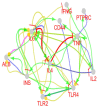Introducing tumor necrosis factor as a prominent player in celiac disease and type 1 diabetes mellitus
- PMID: 32099612
- PMCID: PMC7011075
Introducing tumor necrosis factor as a prominent player in celiac disease and type 1 diabetes mellitus
Abstract
Aim: This study aimed to screen the common genes between celiac disease (CD) and type 1 diabetes mellitus to find critical ones.
Background: Celiac disease is a chronic autoimmune disorder which is correlated to type 1 diabetes mellitus (T1DM) in several molecular pathways. Understanding the clear common molecular mechanism of both diseases is of interest to scientists.
Methods: The related genes to the CD and T1DM were obtained from disease query of STRING and included in two separated PPI networks by Cytoscape software version 3.7.1. The networks were analyzed by network analyzer and the hub nodes were determined. The common hubs between the two networks were selected for further analysis and enriched via gene ontology using ClueGO plugin of Cytoscape software. Also, an action map was provided by Cluepedia application of Cytoscape software.
Results: Two separated networks of 2000 and 430 genes were constructed related to T1DM and CD, respectively. A total of 84 and 28 hubs were determined for T1DM and CD, respectively. There were 11 common hubs between the two networks. The first top hubs of Type 1 Diabetes Mellitus and CD networks were insulin (INS) and tumor necrosis factor (TNF), respectively. Also, 77 biological terms and pathways (in five clusters) were related to the common hubs. Action map revealed a close relationship between hubs.
Conclusion: The result of this study indicated that TNF is key mediator of immune reactions in celiac disease and type 1 diabetes mellitus.
Keywords: Celiac disease; Insulin; TNF; Type 1 diabetes mellitus.
©2019 RIGLD.
Conflict of interest statement
The authors declare that they have no conflict of interest.
Figures



Similar articles
-
Assessment of common and differentially expressed proteins between diabetes mellitus and fatty liver disease: a network analysis.Gastroenterol Hepatol Bed Bench. 2021 Fall;14(Suppl1):S94-S101. Gastroenterol Hepatol Bed Bench. 2021. PMID: 35154608 Free PMC article.
-
Interaction Network Prediction and Analysis of Anorexia Nervosa.Iran J Child Neurol. 2019 Summer;13(3):45-54. Iran J Child Neurol. 2019. PMID: 31327968 Free PMC article.
-
A systems biology analysis protein-protein interaction of NASH and IBD based on comprehensive gene information.Gastroenterol Hepatol Bed Bench. 2017 Summer;10(3):194-201. Gastroenterol Hepatol Bed Bench. 2017. PMID: 29118935 Free PMC article.
-
Unveiling the Link: A Comprehensive Narrative Review of the Relationship Between Type 1 Diabetes Mellitus and Celiac Disease.Cureus. 2023 Oct 26;15(10):e47726. doi: 10.7759/cureus.47726. eCollection 2023 Oct. Cureus. 2023. PMID: 38022113 Free PMC article. Review.
-
Prevalence of celiac disease in Iranian patients with type 1 diabetes: A systematic review and meta-analysis.Indian J Gastroenterol. 2020 Oct;39(5):419-425. doi: 10.1007/s12664-020-01046-7. Epub 2020 Dec 1. Indian J Gastroenterol. 2020. PMID: 33263176
Cited by
-
Nutritional Status in Children with Celiac Disease and Type 1 Diabetes Mellitus-A Narrative Review.Nutrients. 2025 Feb 19;17(4):728. doi: 10.3390/nu17040728. Nutrients. 2025. PMID: 40005056 Free PMC article. Review.
-
Functional maturation of immature β cells: A roadblock for stem cell therapy for type 1 diabetes.World J Stem Cells. 2021 Mar 26;13(3):193-207. doi: 10.4252/wjsc.v13.i3.193. World J Stem Cells. 2021. PMID: 33815669 Free PMC article. Review.
-
Assessment of Dysregulation of HERC6 and Essential Biological Processes in Response to Laser Therapy of Human Arm Skin.J Lasers Med Sci. 2020 Spring;11(2):115-119. doi: 10.34172/jlms.2020.20. Epub 2020 Mar 15. J Lasers Med Sci. 2020. PMID: 32273950 Free PMC article.
-
Gene Expression Profiling in Coeliac Disease Confirmed the Key Role of the Immune System and Revealed a Molecular Overlap with Non-Celiac Gluten Sensitivity.Int J Mol Sci. 2023 Apr 24;24(9):7769. doi: 10.3390/ijms24097769. Int J Mol Sci. 2023. PMID: 37175481 Free PMC article.
-
Inflammation and immunological disarrays are associated with acute exercise in type 2 diabetes.J Diabetes Metab Disord. 2024 Apr 18;23(1):1243-1250. doi: 10.1007/s40200-024-01417-3. eCollection 2024 Jun. J Diabetes Metab Disord. 2024. PMID: 38932912 Free PMC article.
References
-
- Assa A, Frenkel-Nir Y, Tzur D, Katz LH, Shamir R. Large population study shows that adolescents with celiac disease have an increased risk of multiple autoimmune and nonautoimmune comorbidities. Acta Paediatr. 2017;106:967–72. - PubMed
LinkOut - more resources
Full Text Sources
